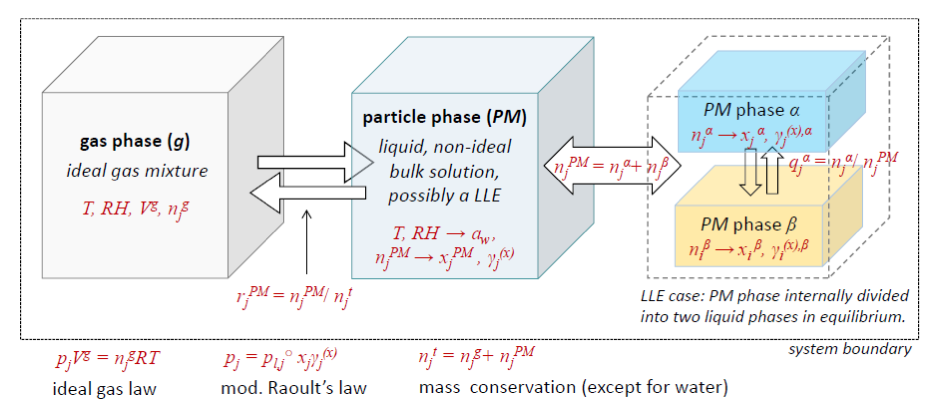Thermodynamic modeling of the composition of liquid aerosol particles
Background
A relevant fraction of the tropospheric accumulation mode aerosol consists of oxidized organic compounds mixed internally (i. e. within particles) with sulfuric and nitric acid, partially up to fully neutralized by ammonia. While chemical substances similar in size and hydrophilicity mix nearly ideally, mixtures consisting of hydrophilic and hydrophobic components are non-ideal and activity coefficients of the components need to be derived to determine the properties of the mixtures.
Non-ideal interactions between organic and inorganic species within aerosol particles impact their hygroscopicity, affect the dissolution and crystallization relative humidity of the inorganic salt fraction, may induce phase separation into organic and inorganic phases, change the gas/particle partitioning of the semivolatile share, and influence heterogeneous and multiphase chemistry.
AIOMFAC
When we started to look into possibilities to determine activity coefficients of typical aerosol mixtures, we found models that were able to calculate activity coefficients for either inorganic or organic mixtures but no one was able to calculate interactions between typical atmospheric ions like sulfates, nitrates and ammonium and oxidized organic compounds. We therefore decided to develop such an activity coefficient model ourselves by combining a Pitzer part for inorganic ions and the UNIFAC model for organic functional groups. Since it is a semi-empirical model we had to gather all experimental data available from literature to parameterize the model.
Andreas Zuend developed such a group-contribution model in his PhD thesis. In 2008, we published the basic version of AIOMFAC (Aerosol Inorganic-Organic Mixtures Functional groups Activity Coefficients) (external page Zuend et al., ACP 2008). Andreas Zuend further extended the parameterization of AIOMFAC during his postdoc with John Seinfeld at Caltech (external page Zuend et al., ACP 2011) and made it accessible to everyone at the website: external page http://www.aiomfac.caltech.edu/.
During her PhD thesis, Gouri Ganbavale improved the temperature dependence of the organic UNIFAC part of AIOMFAC (Ganbavale et al., ACP 2014; external page ACP 2015). For the most recent developments of the model, visit external page Andreas Zuend’s website.
Calculation of phase equilibria
AIOMFAC is the basis to calculate phase equilibria between non-ideal mixtures. The scheme below is taken from external page Zuend et al. (2010) and outlines the modules of the gas/particle partitioning model including liquid-liquid phase separation (LLPS).
